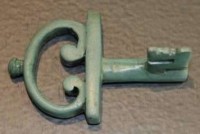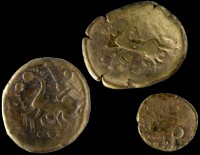 In 2010, archaeologists excavating sites along the route of a new high speed rail line unearthed an exceptional number of Gallic coins and artifacts under communal farmland in the town of Bassing, Lorraine, in northeastern France. The National Institute for Preventive Archaeology (INRAP) announced the find at a press conference in Metz on Thursday, November 29th.
In 2010, archaeologists excavating sites along the route of a new high speed rail line unearthed an exceptional number of Gallic coins and artifacts under communal farmland in the town of Bassing, Lorraine, in northeastern France. The National Institute for Preventive Archaeology (INRAP) announced the find at a press conference in Metz on Thursday, November 29th.
The 3.5 hectare site revealed evidence of continuous occupation from 200 B.C. to 800 A.D., including the remains of a Gallic aristocrat’s home, a villa from the Gallo-Roman period and several early medieval buildings. The earliest structure, an enclosure with a large home and farm within, was built between 150 and 120 B.C. and appears to have been occupied until 14 A.D. The wealth and status of its occupants are testified to by the structures and by the expensive artifacts found, among them a gold ring, bracelets, cobalt blue glass jewelry, Baltic amber and 132 fibulae (ancient safety pins used to close cloaks and garments). Some of the fibulae were imported and others produced locally. The large number suggests the site was a center of trade. This is confirmed by the remains of many Italian amphorae which probably held imported wine, a luxury only the elite of Gaulish society could afford.
bracelets, cobalt blue glass jewelry, Baltic amber and 132 fibulae (ancient safety pins used to close cloaks and garments). Some of the fibulae were imported and others produced locally. The large number suggests the site was a center of trade. This is confirmed by the remains of many Italian amphorae which probably held imported wine, a luxury only the elite of Gaulish society could afford.
 Remains of both Gallic and Roman military artifacts suggest the homeowners weren’t just involved in farming and trade. Fragments of chariots, a battle axe, arrowheads, metallic trimmings of uniforms, nails from hobnailed shoes, cavalry harnesses, several mouthpieces from war horns and one Roman legionary dagger were found on the site, but there is no evidence that life on the property was interrupted or debased by war. In all likelihood, the artifacts identify the elites who lived there as members of the Médiomatrique tribe who populated the area and supported the Roman invasion. Much of the Gallic nobility participated in the fight on the Roman side, sending their own warriors to fight alongside Caesar’s.
Remains of both Gallic and Roman military artifacts suggest the homeowners weren’t just involved in farming and trade. Fragments of chariots, a battle axe, arrowheads, metallic trimmings of uniforms, nails from hobnailed shoes, cavalry harnesses, several mouthpieces from war horns and one Roman legionary dagger were found on the site, but there is no evidence that life on the property was interrupted or debased by war. In all likelihood, the artifacts identify the elites who lived there as members of the Médiomatrique tribe who populated the area and supported the Roman invasion. Much of the Gallic nobility participated in the fight on the Roman side, sending their own warriors to fight alongside Caesar’s.
 The vast amount of cash found on the property was also probably destined for military use. A total of 1165 Gaulish coins from the 1st century B.C., 1,111 silver quinarii (small coins valued at half a denarius or five asses, hence “quinarius”), three gold staters and 51 bronze pieces, were unearthed scattered throughout the site. Some of them are Gallic in style and iconography. Others are rough imitations of Gallo-Roman quinarii (notable for Gallic elements like torques added to Roman profiles) of a kind made between 40 and 30 B.C. when Roman money was in short supply, so Gauls made local versions which could be used in the trade between Rome and Gaul. The total value of the Bassing coins could pay a year and a half’s salary for a legionary at the dawn of the empire.
The vast amount of cash found on the property was also probably destined for military use. A total of 1165 Gaulish coins from the 1st century B.C., 1,111 silver quinarii (small coins valued at half a denarius or five asses, hence “quinarius”), three gold staters and 51 bronze pieces, were unearthed scattered throughout the site. Some of them are Gallic in style and iconography. Others are rough imitations of Gallo-Roman quinarii (notable for Gallic elements like torques added to Roman profiles) of a kind made between 40 and 30 B.C. when Roman money was in short supply, so Gauls made local versions which could be used in the trade between Rome and Gaul. The total value of the Bassing coins could pay a year and a half’s salary for a legionary at the dawn of the empire.
The silver coins come from different areas of Gaul.
74% of the lot come from the East Central Gaul and belongs to Sequani of Besançon, the Lingons Langres, the Aedui Bibracte or Autun. 14% are from the people of the Loire Valley, 7% from the Remi of Reims (Gaul Belgium) and 3% Arverni of Clermont-Ferrand. Finally, a few copies belong to Ségusiaves, people located near Lyon.
![]() This is an exceptional number of coins for a Gallic site. Only 400 coins total have ever been discovered in the major Gaulish town of Alesia, where Julius Caesar famously defeated Vercigetorix in the final battle of the Gallic Wars in 52 B.C., and they were mainly bronze coins and cheaper denominations in regular circulation. Silver was primarily reserved for use by the elite to secure their military power.
This is an exceptional number of coins for a Gallic site. Only 400 coins total have ever been discovered in the major Gaulish town of Alesia, where Julius Caesar famously defeated Vercigetorix in the final battle of the Gallic Wars in 52 B.C., and they were mainly bronze coins and cheaper denominations in regular circulation. Silver was primarily reserved for use by the elite to secure their military power.
Although found scattered, this cache was probably buried in one group between 40 and 20 B.C. and then scattered by ploughs which have been churning the soil since the Middle Ages.